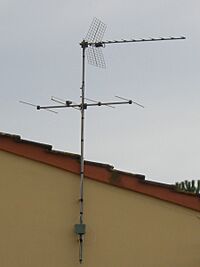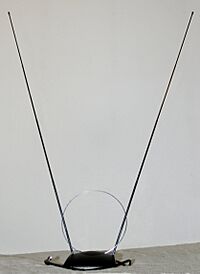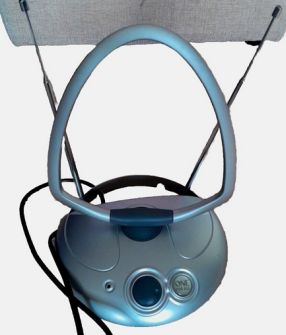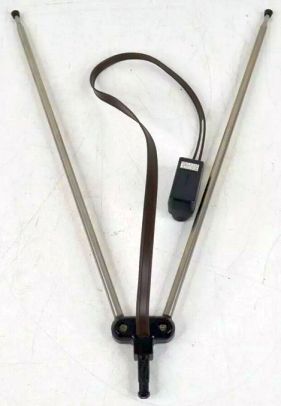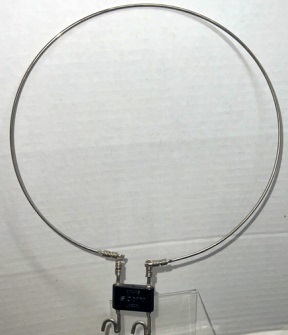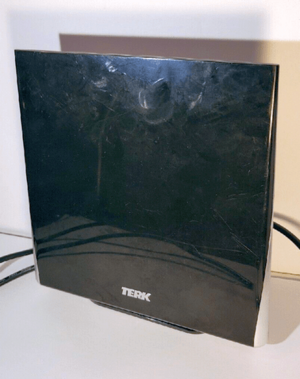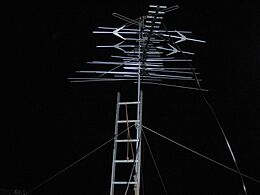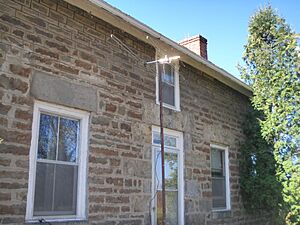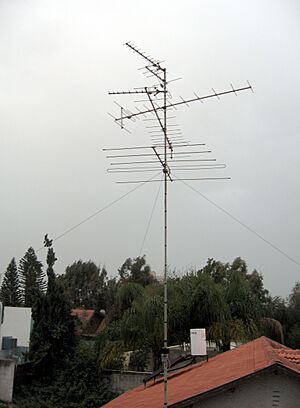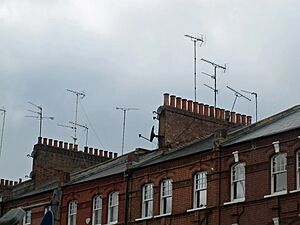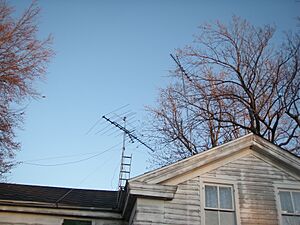Television antenna facts for kids
A television antenna, also known as a TV aerial, is a special device that helps your television (TV) receive signals that are broadcast through the air. These signals come from TV stations and travel as radio waves. TV signals are sent on different frequencies, which are like different channels on a radio. These frequencies are in the very high frequency (VHF) band (around 47 to 250 MHz) and the ultra high frequency (UHF) band (around 470 to 960 MHz).
There are two main kinds of TV antennas: "indoor" and "outdoor." Indoor antennas are small and usually sit on top of or next to your TV. For the best signal, it's good to put them near a window and as high as possible. The most common indoor antennas are "rabbit ears" (which are great for VHF channels) and loop antennas (which work well for UHF channels).
Outdoor antennas are bigger and are usually put on a pole on the roof of a house, or sometimes in an attic. Being high up and protected from weather helps them get a better signal and last longer. Outdoor antennas cost more and are harder to set up. But they are often needed if you live far from TV stations where the signal is weak. Popular outdoor antennas include the Yagi and log periodic types.
Contents
How TV Antennas Work
An antenna's job is to catch the invisible radio waves sent out by TV stations. It turns these waves into tiny electrical signals. These signals then go to your TV's tuner, which picks out the TV show. The antenna connects to your TV with a special cable called a transmission line. Older antennas used a flat cable called "twin-lead," but today, most use a round cable called coaxial cable. This cable is better at stopping interference and plugs into a special port on the back of your TV. If you have an old antenna with twin-lead cable, you might need a small adapter called a balun to connect it to a modern TV.
TV signals travel in a straight line, like light. They can be blocked by hills or the curve of the Earth. This means a TV station's signal usually only reaches about 40 to 60 miles (65 to 95 km), depending on the land.
Old TV vs. New TV Signals
Before 2006, many countries used an older system called analog television. Now, most countries use digital television (DTV). The good news is that the same antennas used for old analog TV signals also work for the new digital TV signals!
Sometimes, sellers might try to sell you a special "digital" or "high-definition television" (HDTV) antenna. But usually, your old antenna will work just fine for digital TV. Buying a new "digital" antenna might not be necessary, and sometimes these new antennas are only good for UHF channels, which could mean you miss out on some digital channels that are still on VHF frequencies.
Indoor Antennas: Easy Setup
Indoor antennas are placed right on your TV or on a table nearby. They connect to the TV with a short cable. Because they are inside, they can't be as big as outdoor antennas, and building walls can block some signals. This means indoor antennas usually don't get as good reception as outdoor ones.
However, indoor antennas are often perfect if you live in a city or suburb. In these areas, TV stations usually send out strong signals that reach well. If you live in a rural area far from TV stations, you might need an outdoor antenna for a clear picture.
Some indoor antennas have a dial with different settings. You can turn this dial while watching your TV screen to find the best picture.
Rabbit Ears: The Classic Choice
The "rabbit ears" antenna is one of the oldest and most common indoor antennas. It often comes with new TVs. It's made of two metal rods that can slide in and out, like a telescope. These rods can extend to about 3 feet (1 meter) long.
Rabbit ears are best for receiving VHF TV channels. For the clearest picture, you can try adjusting the length of the rods. They work best when the rods are about a quarter of the signal's wavelength. You can also move the rods into a "V" shape. This helps them pick up signals from different directions.
Whip Antenna: For Portable TVs
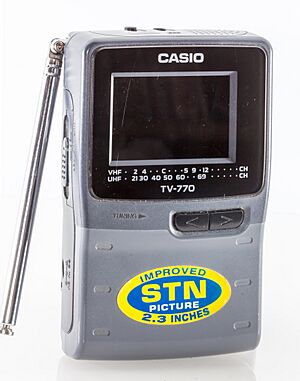
Some small, portable TVs use a "whip antenna." This is a single metal rod that can extend to about 3 feet (1 meter) long. It can be pushed back into the TV when not in use. A whip antenna picks up signals from all directions around it.
Loop Antenna: For UHF Channels
UHF channels are often picked up by a "loop antenna," which is a single circle of wire. Since "rabbit ears" only work for VHF, many indoor antennas combine rabbit ears with a UHF loop on the same base. This way, you can get all the TV channels. In some countries, like the UK, TV broadcasts are only on the UHF band, so a loop antenna is essential.
Flat Antenna: Modern and Stylish
"Flat antennas" are a newer type of indoor antenna. They are thin, light, and usually square-shaped. They are designed to pick up signals from many directions and look good in modern homes. You can stand them up, hang them on a wall, or even put them on a window. Inside, these flat antennas are actually loop antennas with their wire hidden in the plastic.
Outdoor Antennas: Stronger Signals
When you need a stronger signal, especially if you live far from TV stations, an outdoor antenna is usually the best choice. These antennas are "directional," meaning they work best when pointed directly at the TV station. The more "gain" (strength) an antenna has, the narrower its best reception area.
Outdoor antennas can make the signal much stronger, helping you get a clearer picture and reduce "ghosting" (blurry, repeated images) that used to happen with old analog TV. Being high up on a roof also helps a lot because there are fewer walls or obstacles blocking the signal.
Many outdoor antennas are based on designs like the Yagi or log-periodic dipole array. These antennas have several metal rods lined up on a long boom. These rods help catch the radio waves and turn them into electrical signals. Generally, the more rods an antenna has, the stronger the signal it can pick up and the more directional it is.
Because TV signals are spread across a wide range of frequencies, it's hard for one antenna to catch them all perfectly. So, you can use separate antennas for VHF and UHF, or a "combo" antenna that combines both. A combo antenna usually has longer rods at the back for VHF and shorter rods at the front for UHF.
If the TV stations you want to watch are in different directions, you have a couple of options. You can put two or more outdoor antennas on the same pole, each pointed at a different station. Or, you can use a single antenna mounted on a "rotator." A rotator is a motor that lets you turn the antenna from inside your house to point it in the best direction for the channel you want to watch.
Setting Up Your TV Antenna
Antennas are often placed on rooftops or in attics. Putting an antenna indoors makes the signal weaker because it's lower to the ground and walls block the waves. Directional antennas need to be pointed towards the TV station. Usually, you don't need to be super precise. In many areas, all the TV stations are in roughly the same direction, so one antenna works for all of them.
Old analog television signals could have "ghosting," which looked like blurry, repeated images on the screen. This happened when the signal bounced off buildings or mountains, creating multiple copies of the signal that arrived at slightly different times. Digital TV doesn't have ghosting. However, if the signal is too weak or has too much interference, digital TV might just stop working or show a blocky picture.
Rooftop and Other Outdoor Antennas
Antennas are usually attached to roofs on a pole to raise them higher. The higher the antenna, the better it generally works. An antenna that can pick up weaker signals will help if you are far from the TV station. Buildings, mountains, or thick forests can weaken the signal. Sometimes, the signal bounces off these things, and you can still get a usable signal.
It's important to be safe when installing antennas, especially tall ones. They can attract lightning and need to be properly grounded with a lightning arrester to protect your home. Tall poles should also be secured with strong wires called "guy-wires" so they don't fall over in bad weather. Always make sure the antenna isn't near power lines. Also, check local rules about how tall an antenna pole can be without needing special permission.
Indoor Antennas: Simple Setup
As we talked about, indoor antennas are easy to set up when signals are strong enough. You just plug the antenna into your TV and place it in a good spot, often on top of the TV. You might need to move it around a bit to find the best picture. Sometimes, a "TV booster" (an amplifier) can help make the signal stronger for indoor antennas.
Attic Installation: A Hidden Option
Sometimes people don't want an antenna on their roof. In these cases, outdoor antennas can be put in the attic. There are even antennas made just for attics. Putting an antenna in the attic does make the signal weaker because it's lower and walls block some of the signal. But if you live in an area with strong signals, it might still work well. For example, a roof with asphalt shingles and plywood can block about half of the signal.
Using Multiple Antennas or a Rotator
If you want to watch TV stations that are in different directions, you have a few choices. You can use a "rotator" that turns your antenna with an electric motor. Or, you can use two or more antennas, each pointed at a different station. These antennas are then connected to your TV using special circuits.
If you use multiple antennas, they need to be spaced far enough apart so they don't interfere with each other. For example, they should be at least half the wavelength of the lowest frequency signal apart. Also, the cables connecting them to your TV should be the exact same length. This helps prevent problems with the signal arriving at different times, which could cause issues like ghosting with older analog TVs.
Safety Tips
- TV antennas are made of metal and can attract lightning. Always use a lightning arrester and make sure the antenna and its pole are properly connected to a grounding rod in the ground.
- Antenna poles, especially tall ones, should be secured with strong wires to keep them from falling in bad weather. Make sure they are installed far away from power lines.
- Be very careful when working on a roof to install or adjust an antenna. It can be dangerous!
See also
- Broadcast television systems
- Radio masts and towers
- Satellite dish
- Satellite television
- Terrestrial television
Images for kids


